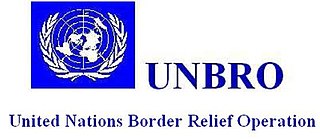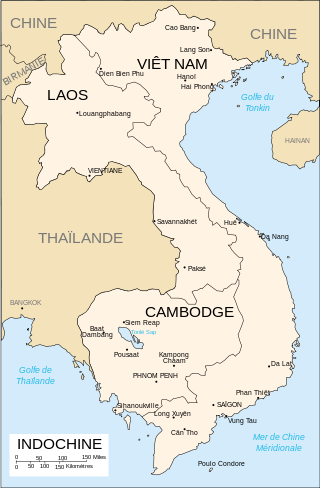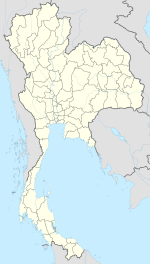
The United Nations Border Relief Operation (UNBRO) was a donor-nation funded relief effort for Cambodian refugees and others affected by years of warfare along the Thai-Cambodian border. It functioned from 1982 until 2001.

The Cambodian–Vietnamese War, known in Vietnam as the Counter-offensive on the Southwestern border, and by Cambodian nationalists as the Vietnamese invasion of Cambodia, was an armed conflict between Democratic Kampuchea, controlled by Pol Pot's Khmer Rouge, and the Socialist Republic of Vietnam. The war began with repeated attacks by the Liberation Army of Kampuchea on the southwestern border of Vietnam, particularly the Ba Chúc massacre which resulted in the deaths of over 3,000 Vietnamese civilians. On 23 December 1978, 10 out of 19 divisions of Khmer Rouge's military divisions opened fire along the shared Southwestern borderline with Vietnam with the goal of invading the Vietnamese provinces of Đồng Tháp, An Giang and Kiên Giang. On 25 December 1978, Vietnam launched a full-scale invasion of Kampuchea, and subsequently occupied the country and removed the government of the Communist Party of Kampuchea from power.

The Dângrêk Mountains, also the Dângrêk Range, is a mountain range forming a natural border between Cambodia and Thailand.

The Khmer People's National Liberation Front was a political front organized in 1979 in opposition to the Vietnamese-installed People's Republic of Kampuchea (PRK) regime in Cambodia. The 200,000 Vietnamese troops supporting the PRK, as well as Khmer Rouge defectors, had ousted the Democratic Kampuchea regime of Pol Pot, and were initially welcomed by the majority of Cambodians as liberators. Some Khmer, though, recalled the two countries' historical rivalry and feared that the Vietnamese would attempt to subjugate the country, and began to oppose their military presence. Members of the KPNLF supported this view.
The MOULINAKA was a pro-Sihanouk military organization formed in August 1979 by an armed group on the Thai-Cambodian border.

The Khmer Serei were an anti-communist and anti-monarchist guerrilla force founded by Cambodian nationalist Son Ngoc Thanh. In 1959, he published 'The Manifesto of the Khmer Serei' claiming that Sihanouk was supporting the 'communization' of Kampuchea. In the 1960s, the Khmer Serei were growing in numbers, hoping to become a major political and fighting force.

The Khao-I-Dang (KID) Holding Center was a Cambodian refugee camp 20 km north of Aranyaprathet in Prachinburi. The longest-lived refugee camp on the Thai-Cambodian border, it was established in late 1979, administered by the Thai Interior Ministry and the United Nations High Commissioner for Refugees (UNHCR), unlike other camps on the border, which were administered by a coalition made up of UNICEF, the World Food Program, International Committee of the Red Cross (ICRC) (briefly), and after 1982, the United Nations Border Relief Operation (UNBRO). The camp held refugees fleeing the Cambodian–Vietnamese War.

The People's Republic of Kampuchea (PRK) was a partially recognised client state in Southeast Asia supported by Vietnam which existed from 1979 to 1989. It was founded in Cambodia by the Kampuchean United Front for National Salvation, a group of Cambodian communists who were dissatisfied with the Khmer Rouge due to its oppressive rule of Cambodia and defected from it after the overthrow of Democratic Kampuchea, Pol Pot's government. Brought about by an invasion from Vietnam, which routed the Khmer Rouge armies, it had Vietnam and the Soviet Union as its main allies.
After the 1978 Vietnamese invasion of Cambodia and subsequent collapse of Democratic Kampuchea in 1979, the Khmer Rouge fled to the border regions of Thailand, and, with assistance from China, Pol Pot's troops managed to regroup and reorganize in forested and mountainous zones on the Thai-Cambodian border. During the 1980s and early 1990s Khmer Rouge forces operated from inside refugee camps in Thailand, in an attempt to de-stabilize the pro-Hanoi People's Republic of Kampuchea's government, which Thailand refused to recognise. Thailand and Vietnam faced off across the Thai-Cambodian border with frequent Vietnamese incursions and shellings into Thai territory throughout the 1980s in pursuit of Cambodian guerrillas who kept attacking Vietnamese occupation forces.
The earliest traces of armed conflict in the territory that constitutes modern Cambodia date to the Iron Age settlement of Phum Snay in north-western Cambodia.

The Khmer People's National Liberation Armed Forces (KPNLAF) was the military component of the Khmer People's National Liberation Front (KPNLF) a political front organized in 1979 in opposition to the Vietnamese-installed People's Republic of Kampuchea (PRK) regime in Cambodia. The KPNLAF was loyal to Son Sann, a former Prime Minister under Prince Norodom Sihanouk and the founder of the KPNLF political movement.
General Sak Sutsakhan was a Cambodian politician and soldier who had a long career in the country's politics. He was the last Head of State of the Khmer Republic, the regime overthrown by the Khmer Rouge in 1975. Sak Sutsakhan formed a pro-US force known as the Khmer Sâ. As a businessman, Sak Susakhan notably owned a Dairy Queen franchise in Anaheim, California.

General Dien Del was a prominent Cambodian military officer and later, politician. He directed combat operations in Cambodia, first as a general in the Army of the Khmer Republic (1970–1975) and then as a leader of Khmer People's National Liberation Front (KPNLF) guerrilla forces fighting against the Vietnamese occupation (1979–1992). Following Vietnam's withdrawal from Cambodia in 1990, he presided over the demobilization of the KPNLF's armed forces in February 1992. In 1998 he was elected to the National Legislative Assembly as a member of FUNCINPEC. He spent the last fifteen years of his career as advisor to the Cambodian government.
Sa Kaeo Refugee Camp was the first organized refugee relief camp established on the Thai-Cambodian border. It was built by the Royal Thai Government with support from international relief agencies including the United Nations. It opened in October 1979 and closed in early-July 1980. At its peak the population exceeded 30,000 refugees; no formal census was ever conducted.
Site Two Refugee Camp was the largest refugee camp on the Thai-Cambodian border and, for several years, the largest refugee camp in Southeast Asia. The camp was established in January 1985 during the 1984-1985 Vietnamese dry-season offensive against guerrilla forces opposing Vietnam's occupation of Cambodia.

Nong Samet Refugee Camp, in Nong Samet Village, Khok Sung District, Sa Kaeo Province, Thailand, was a refugee camp on the Thai-Cambodian border and served as a power base for the Khmer People's National Liberation Front (KPNLF) until its destruction by the Vietnamese military in late 1984.

The Indochina refugee crisis was the large outflow of people from the former French colonies of Indochina, comprising the countries of Vietnam, Cambodia, and Laos, after communist governments were established in 1975. Over the next 25 years and out of a total Indochinese population in 1975 of 56 million, more than 3 million people would undertake the dangerous journey to become refugees in other countries of Southeast Asia, Hong Kong, or China. According to the United Nations High Commissioner for Refugees, 250,000 Vietnamese refugees had perished at sea by July 1986. More than 2.5 million Indochinese were resettled, mostly in North America, Australia, and Europe. More than 525,000 were repatriated, either voluntarily or involuntarily, mainly from Cambodia.
The Cambodian humanitarian crisis from 1969 to 1993 consisted of a series of related events which resulted in the death, displacement, or resettlement abroad of millions of Cambodians.

The Cambodia–Thailand border is the international border between Cambodia and Thailand. The border is 817 km (508 mi) in length and runs from the tripoint with Laos in the north-east to the Gulf of Thailand in the south.

The Dangrek genocide also known as "the Preah Vihear pushback" is a border incident which took place along the Dangrek Mountain Range on the Thai-Cambodian border which resulted in the death of many mostly Sino-Khmer refugees who were refused asylum by the Kingdom of Thailand in June 1979.













